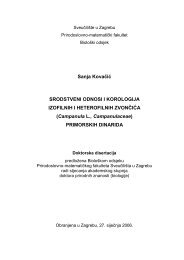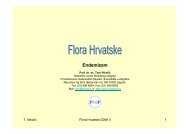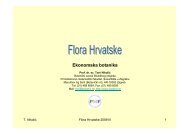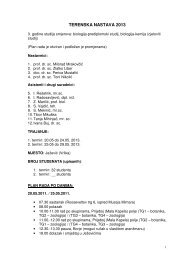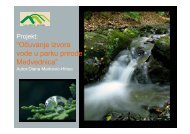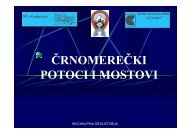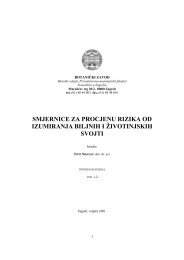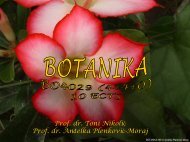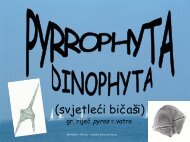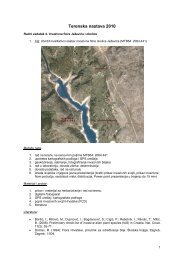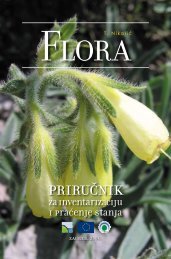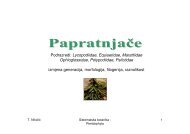important plant areas in central and eastern europe - hirc.botanic.hr ...
important plant areas in central and eastern europe - hirc.botanic.hr ...
important plant areas in central and eastern europe - hirc.botanic.hr ...
You also want an ePaper? Increase the reach of your titles
YUMPU automatically turns print PDFs into web optimized ePapers that Google loves.
Serbia <strong>and</strong> MontenegroCurrent IPA statisticsTotal number of IPAs: 59Number of cross-border IPAs: 12Criteria <strong>and</strong> methodologyCriterion A: the Serbian Red Data Book (Vol. 1 <strong>and</strong> database for Vol. 2) was used toidentify IPA species, <strong>and</strong> an assessment of <strong>in</strong>ternationally <strong>important</strong> species wascompleted.The list <strong>in</strong>cludes species hav<strong>in</strong>g most or all or their distribution <strong>in</strong> Serbia <strong>and</strong>was mapped used 10 x 10 km squaresCriterion B: the follow<strong>in</strong>g approach was adopted for this criterion: general speciesrichness with particular emphasis on rare, endemics <strong>and</strong> relict species, <strong>and</strong> diversity of<strong>plant</strong> communities. Species richness was assessed us<strong>in</strong>g 50 x 50 km squares.Criterion C: t<strong>hr</strong>eatened, as well as rare <strong>and</strong> unique habitats, <strong>in</strong>clud<strong>in</strong>g the limestone cliffs<strong>in</strong> gorges <strong>and</strong> canyons, forests of endemic trees <strong>and</strong> s<strong>hr</strong>ubs, steppe <strong>and</strong> s<strong>and</strong>y steppe,relict peat bog <strong>and</strong> wetl<strong>and</strong> <strong>plant</strong> communities were mapped at 10 x 10 km squaresThe ma<strong>in</strong> challenges were the lack of Serbian <strong>and</strong> Balkan species <strong>and</strong> habitats <strong>in</strong>cludedon regional Red Lists or political documents. Maps of IPA site details, species <strong>and</strong>habitats are held <strong>in</strong> GIS <strong>and</strong> databases.Protection, t<strong>hr</strong>eats <strong>and</strong> conservation issuesOf the IPAs identified so far five are <strong>in</strong> National Parks <strong>and</strong> 15 <strong>in</strong> nature reserves ofvarious status, although some of the IPAs have no current protection. The IPAs selectedso far have been concentrated on the mounta<strong>in</strong>ous <strong>areas</strong> with their many endemic <strong>and</strong>relict species, <strong>areas</strong> of the rare habitats of steppe, forest steppe <strong>and</strong> s<strong>and</strong>y steppe, <strong>and</strong>the few peat bogs, marshes <strong>and</strong> wet meadows.Recommendations■ Cont<strong>in</strong>ue the identification <strong>and</strong>validation process of potential IPAs <strong>in</strong>Serbia■ Publication of ‘IPAs <strong>in</strong> Serbia’ is plannedto be f<strong>in</strong>ished <strong>in</strong> 2005.■ Promote the <strong>in</strong>clusion of Serbia <strong>and</strong>Balkan species <strong>and</strong> habitats <strong>in</strong> European<strong>and</strong> International lists of conservationstatus■ Use of IPA data <strong>in</strong> conservationstrategic plann<strong>in</strong>g <strong>in</strong> Serbia <strong>and</strong>establish<strong>in</strong>g net of protected <strong>areas</strong> <strong>in</strong>Serbia.■ Close cooperation with the M<strong>in</strong>istry ofScience, Natural Resources <strong>and</strong>Environmental Protection, othergovernment agencies <strong>and</strong> stakeholdersto protect <strong>and</strong> manage IPAsDeliblatska PescaraDeliblatska Pescara <strong>in</strong> north east Serbia is a unique area of <strong>in</strong>l<strong>and</strong> s<strong>and</strong> dunes <strong>and</strong> is afloristically rich part of the Pannonian Pla<strong>in</strong>.The dunes <strong>and</strong> adjacent loess hills conta<strong>in</strong>many rare types of <strong>plant</strong> communities such as steppe grassl<strong>and</strong>s, s<strong>and</strong>y steppe <strong>and</strong> foreststeppe, as well as <strong>areas</strong> of deciduous forest <strong>and</strong> flooded Danube streams.The site islargely protected but the rare habitats are t<strong>hr</strong>eatened by afforestation by p<strong>in</strong>e <strong>and</strong> falseacacia.This site is also an Important Bird Area.The picture represent an characteristicl<strong>and</strong>scape with feather grass (Stipa sabulosa) community mixed with groups of commonjuniper (Juniperus commnunis) <strong>and</strong> natural of white oak (Quercus pubescens) <strong>and</strong> silverwhite lime (Tilia tomentosa) forests.VLADIMIR STEVANOVI˘C77



